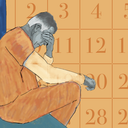
The United States Supreme Court has granted a new trial to Louisiana death-row prisoner Robert McCoy (pictured), whose lawyer admitted his guilt despite McCoy’s “adament” and “vociferous” insistence that he was innocent. Facing what counsel believed was overwhelming evidence of guilt and hoping to persuade the jury to spare McCoy’s life, defense lawyer Larry English told jurors his client had “committed three murders.… [H]e’s guilty.” In a 6 – 3 opinion for the Court on May 14, Justice Ruth Bader Ginsburg wrote: “With individual liberty — and, in capital cases, life — at stake, it is the defendant’s prerogative, not counsel’s, to decide on the objective of his defense: to admit guilt in the hope of gaining mercy at the sentencing stage, or to maintain his innocence, leaving it to the State to prove his guilt beyond a reasonable doubt.” Justices Alito, Thomas, and Gorsuch dissented. At trial, McCoy’s defense counsel informed the jury that it could reach no other conclusion but that McCoy — who was charged with murdering the son, mother, and stepfather of his estranged wife — “was the cause of these individuals’ death,” even though McCoy had consistently maintained his innocence and repeatedly objected to counsel’s strategy. The trial court denied McCoy’s objections. On appeal, the Louisiana Supreme Court affirmed the conviction, ruling that a lawyer has the authority to concede guilt against the wishes of his client because counsel “reasonably believed that admitting guilt” would be the “best chance” to avoid a death verdict. The U.S. Supreme Court reversed. Justice Ginsburg explained that “the ‘assistance’ of counsel” guaranteed by the Sixth Amendment does not require a defendant to “surrender control entirely to counsel. … Some decisions,” she wrote, “are reserved for the client — notably, whether to plead guilty, waive the right to a jury trial, testify in one’s own behalf, and forgo an appeal.” Here, the Court found that McCoy’s objective — to maintain that he was innocent of murdering his family — was irreconcilable with trial counsel’s objective — to avoid a death sentence. “When a client expressly asserts that the objective of ‘his defence’ is to maintain innocence of the charged criminal acts,” the Court held, “his lawyer must abide by that objective and may not override it by conceding guilt.” The dissent disagreed that trial counsel had conceded McCoy’s guilt by telling the jury that his client killed the victims, saying that counsel had stressed that McCoy lacked the intent to kill necessary for first-degree murder and that McCoy therefore was guilty only of second-degree murder. It also minimized the need for the ruling, describing the problem as “a rare plant that blooms every decade or so” and one that was unlikely to recur. In April 2017, the Louisiana Association of Criminal Defense Lawyers had filed a brief supporting McCoy’s petition, pointing to a pattern of cases in which Louisiana state courts had resolved disagreements between capital defendants and their lawyers in whatever manner had been most detrimental to the defendant. “Rather than a principled and consistent commitment to the autonomy and dignity of capital defendants,” the defense lawyers wrote, “the Louisiana Supreme Court has adopted a set of rules that ameliorates always to the benefit of the state, and never to the defendant.” In a statement released to the media, McCoy’s lawyer, Richard Bourke, said “The ruling restores in Louisiana the constitutional right of every individual to present their defense to a jury. While rare in the rest of the country, … Mr. McCoy’s was one of ten death sentences imposed in Louisiana since 2000 that have been tainted with the same flaw.”
(Mark Sherman, Supreme Court rules for inmate whose lawyer conceded guilt, Associated Press, May 14, 2018; Lawrence Hurley, U.S. high court throws out Louisiana death row inmate’s conviction, Reuters, May 14, 2018; Statement from Attorney for Robert McCoy in Response to Today’s SCOTUS Ruling in McCoy v. Louisiana, May 14, 2018) Read the Opinion. See U.S. Supreme Court and Representation.


